The Central Libraries > Mid-Manhattan
Library > Historical Postcards
A Record of Style
Two pathways to style can be traced through the
Historical Postcards of New York City. The
images on the front of the cards display an amazing
variety of techniques available to the postcard
maker in depicting a view. The backs of the
cards illustrate typographic styles popular at
the turn of the century, as well as legal requirements
that help to date the cards.
The image side: technical virtuosity.
Postcard creators and publishers made profitable use
of new printmaking methods in lithography, photography,
etching and screenprinting, often adding a few creative
flourishes of their own.
Hold to light cards
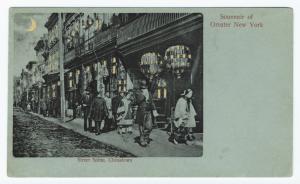 Street scene, Chinatown.
Street scene, Chinatown.
Digital ID: 836339
This depiction of a Street Scene in Chinatown at night
is a “Hold to Light” card. Holding
these two-layered cards to a light source accentuates
the light from the moon, lanterns and windows depicted.
Tinsel and glitter
 New York harbor from Brooklyn
Bridge.
New York harbor from Brooklyn
Bridge.
Digital ID: 836657
Silver and gold glitter was applied to emphasize
contours of buildings or to outline forms. In
this image of New York Harbor from the Brooklyn
Bridge, red and silver glitter glides the eye to
the boats, the shoreline, and the horizon.
Embossing
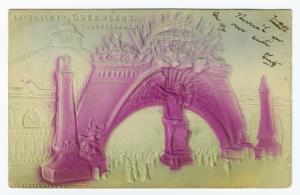
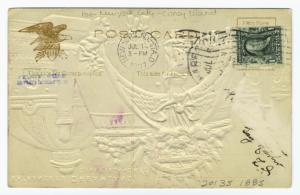 Entrance to Dreamland,
Coney Island, N.Y.
Entrance to Dreamland,
Coney Island, N.Y.
Digital ID: 836497.
Verso: Digital ID: 836498.
Elaborate
embossing on cards depicting Coney Island and
other places for lighthearted pursuits made them
perfect souvenirs. Owners of these cards
could also reproduce the image by rubbing a pencil
across a piece of paper placed over the card.
Real photographs
 View from the Woolworth Tower looking West
View from the Woolworth Tower looking West
Digital
ID: 836037
The rising popularity of photography ensured its
prominence as a postcard medium, as negatives could
easily be developed on photopaper with pre-printed
text on the back. Publishers distinguished “real
photographs” from other printing techniques
with an announcement on the card. This
View
from the Woolworth Tower looking West is identified
as
“a genuine photograph“ on
the reverse. “Real photograph” postcards
are more likely to represent the view with some
historical veracity.
Lithographic Techniques
 Grace Church and the Wanamaker
Grace Church and the Wanamaker
Stores, Broadway,
New York.
Digital ID: 836265
Technical advances in lithography permitted large
print runs of postcards using different hand-colored
plates for each color. Imaginative applications
of ink sometimes give the New York streets a
fairytale flavor.
Stencil and brush (pochoir print)
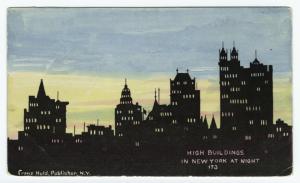 High buildings in New York at night.
High buildings in New York at night.
Digital ID: 836959
The stencil and brush methods used in this evocative
rendition of a New York City sunset were precursors
to screenprinting techniques developed and
adapted by the pop art movement half a century
later.
The address side: a chronology of style

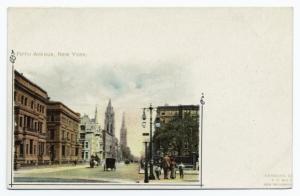 Fifth Avenue, New York.
Fifth Avenue, New York.
Digital ID: 836592 (back), Digital ID: 836591.
For tourists, immigrants, residents and relatives,
a souvenir of the sights of the Big City proved
irresistible, and postcard publishers responded
with an inexhaustible supply of sets picturing New
York. The
Historical Postcards of the Picture Collection
show every stage of the “golden age” of
picture postcards.
Postcards published from 1893 (when the first set
of picture postcards in the United States was issued)
through 1898 are termed “pioneer”. Because
the Post Office reserved the term “postcard” for
blank cards with postage affixed, these cards are
imprinted with other descriptive words, such as “Souvenir.” They
also cost 2¢ to mail.

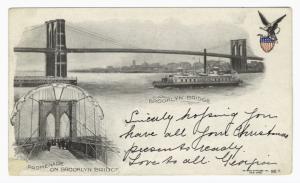 Brooklyn Bridge.
Brooklyn Bridge.
Digital ID: 836122 (back); Digital ID: 836121In 1898, the U.S. government extended to private
publishers the same 1¢ postage rate in effect
for the blank government cards, but required special
wording on the address side of the card advertising
their generosity. Postcard makers embellished
the prescribed language with elaborate typographies.
On Dec. 24, 1901, the language requirements were
eased—the term “Post Card” was
permitted. Flamboyant typographies showed
no sign of diminishing.
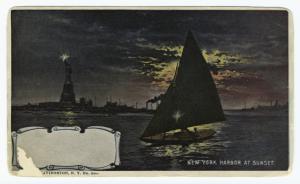 New York Harbor at
Sunset.
New York Harbor at
Sunset.
Digital ID: 836649In the early years, the postcard correspondent
was strictly forbidden to write anything other than
the address on the back of the card. As the
aesthetic quality of the pictures on the front of
the card advanced, fitting more than a signature
became problematic. This view of a violet sunset
at sea allows only a small scroll at the bottom
left for the message.
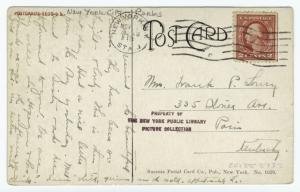
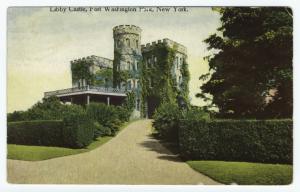 Libby Castle,
Fort Washington Park, New York.
Libby Castle,
Fort Washington Park, New York.
Digital ID: 836876 (back), 836875
On March 2, 1907, the space on the back of the
card was divided to allow for messages, and the
format of the postcard as we know it today came
into being.